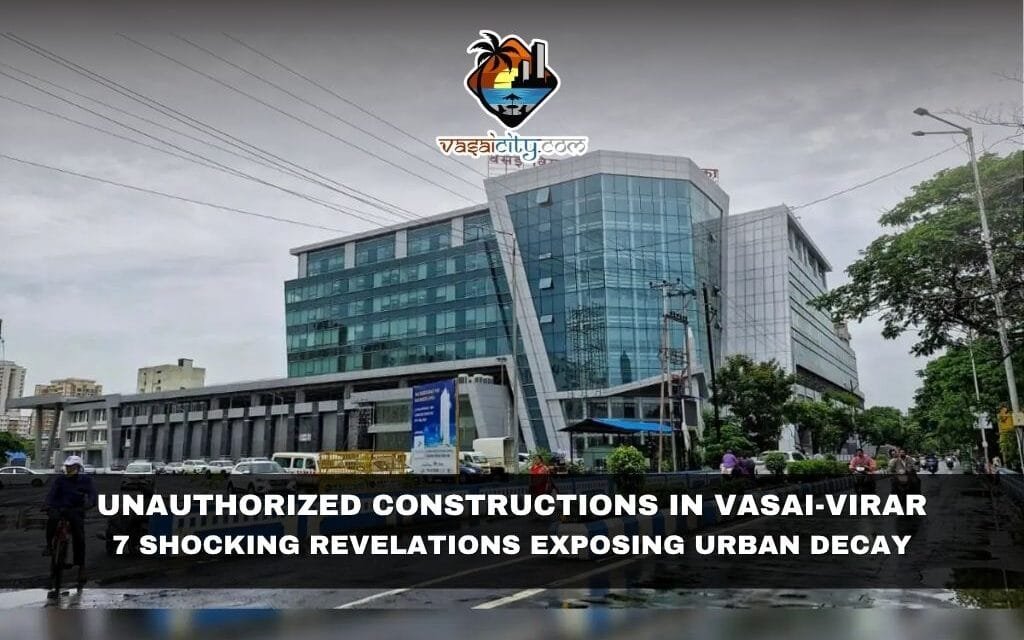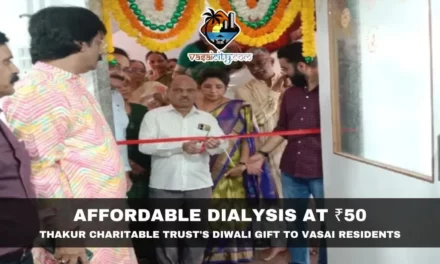Unauthorized constructions in Vasai-Virar have become a serious concern, overshadowing the city’s rich history and transforming its identity from a serene coastal town to a congested urban sprawl. Once known for its cultural heritage, greenery, and clean beaches, Vasai-Virar is now making headlines for the wrong reasons – massive illegal constructions, poor infrastructure, and administrative inaction.
Table of Contents
🏰 A City with a Glorious Past
Vasai’s historical roots trace back to the Portuguese era and even earlier, during the rule of Gujarat’s Sultan Bahadur Shah. The Vasai Fort stands as a testament to the city’s past glory. The region has also been known for its organic vegetables, Vasai’s famed bananas, and silver pomfret, a fish that has earned state-level recognition.
However, these natural and cultural treasures have taken a backseat due to unchecked urbanization, most of it illegal.
🏗️ How Unauthorized Constructions Took Over
From Vasai to Nalasopara to Virar, unauthorized buildings have mushroomed around key railway stations and public areas. Narrow lanes, choked drains, and waterlogged roads are now a daily challenge for residents. Areas like Nalasopara East often face knee-deep flooding after just 30 minutes of rain, turning roads into rivers of garbage and sewage.
In the monsoon, even the ST depot near Vasai West station witnesses drain water overflowing onto roads, inviting diseases and daily commuting chaos. The core reason? Unauthorized constructions and the lack of urban planning.
🚨 The 41 Demolitions That Shook Nalasopara
In November 2023, the situation reached a boiling point when the Mumbai High Court ordered the demolition of 41 illegal buildings in Agarwal Nagari, Nalasopara East. These buildings were declared unauthorized, resulting in the displacement of over 2,500 families.
This action was reminiscent of earlier crackdowns in Digha (Navi Mumbai) with 94 illegal buildings and in Kalyan-Dombivli where 65 buildings faced legal scrutiny. Residents in these areas continue to live in fear, uncertain about their future.
📜 The Genesis: Land Grab and Fake Documents
The Nalasopara case dates back to 2006, when former Bahujan Vikas Aghadi corporator Sitaram Gupta and his nephew Arun Gupta allegedly encroached on a 30-acre land—partly private, partly reserved for a dumping yard and a sewage treatment plant.
From 2010 to 2012, they constructed 41 buildings using fake building permissions (CCs) and occupation certificates (OCs). These structures housed thousands until their demolition, causing immense loss and sparking debates on accountability.
The issue had been flagged for years by former Shiv Sena leader Dhananjay Gawde, but action only came after judicial intervention.
🕵️ ED Raids Unveil Massive Corruption
The matter escalated dramatically in May 2025 when the Enforcement Directorate (ED) launched raids in connection with the unauthorized constructions. Officials were stunned by the seizure of ₹8 crore in cash and ₹23 crore worth of gold and jewelry from VVMC’s town planning officials, including Deputy Director Y.S. Reddy.
These findings raised eyebrows even more than wealth uncovered in Mumbai Municipal Corporation, considered Asia’s richest civic body. The wealth amassed by Vasai-Virar officials left the public stunned.
🏛️ Former Commissioner Under Scrutiny
The ED’s next move came swiftly. In late July 2025, raids were conducted at the residence of former VVMC Commissioner Anilkumar Pawar. Interestingly, Pawar had officially been transferred on 17th July, but didn’t vacate his post until 28th July, allowing a 10-day window that has sparked intense speculation.
Why did he delay stepping down? What decisions were made during this brief but crucial period? These questions have intensified public suspicion and media scrutiny.
🗳️ Political Pressure Mounts
The recent Monsoon Session of the Maharashtra Assembly brought further attention to this crisis. Local BJP MLAs Rajan Naik and Sneha Dubey raised the issue on the assembly floor, demanding immediate and sweeping action against those responsible for Vasai-Virar’s decline.
Following their intervention, the ED’s investigations appear to have picked up pace, signaling that unauthorized constructions in Vasai-Virar are now firmly on the radar of enforcement agencies.
🔄 Can the City Reclaim Its Identity?
The unchecked rise in illegal structures didn’t happen overnight. Years of political backing, administrative neglect, and corruption have led to the city’s deterioration.
Unless concrete action is taken to demolish unauthorized buildings, hold guilty officials accountable, and implement strict urban planning policies, the city’s transformation into a slum-like metropolis may be irreversible.
Only time will tell whether this crackdown leads to true reform—or if political networks will once again rebuild what has been torn down.









